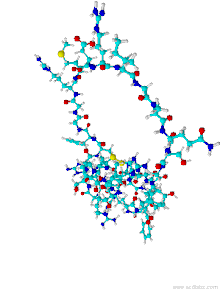Urodilatin
Urodilatin (URO) is a hormone that causes natriuresis by increasing renal blood flow. It is secreted in response to increased mean arterial pressure and increased blood volume from the cells of the distal tubule and collecting duct. It is important in oliguric patients (such as those with acute kidney injury and chronic kidney failure) as it lowers serum creatinine and increases urine output.
.svg.png.webp) | |
 | |
| Identifiers | |
|---|---|
3D model (JSmol) |
|
| ChemSpider | |
| KEGG | |
| MeSH | Urodilatin |
PubChem CID |
|
| UNII | |
CompTox Dashboard (EPA) |
|
| |
| |
| Properties | |
| C145H234N52O44S3 | |
| Molar mass | 3505.926 |
Except where otherwise noted, data are given for materials in their standard state (at 25 °C [77 °F], 100 kPa).
Infobox references | |
Interactions
Atrial natriuretic peptide (CDD/ANP-99-126)[1] is a hormone system of clinical importance. Urodilatin (CDD/ ANP-95-126) is a homologue natriuretic peptide that differs from CDD/ANP-99-126, which is excreted into the circulation via exocytosis. The prototype of the natriuretic hormones is cardiodilatin / atrial natriuretic peptide (CDD/ANP).[2] The endocrine heart is composed of specific myoendocrine cells that synthesize and secrete the natriuretic peptide hormones, which exhibit diuretic and vasorelaxant properties; secretion is the basis for a paracrine system regulating water and sodium reabsorption.[3]
Research efforts since the early 1980s have studied their effects on electrolyte homeostasis.[4] When administered intravenously, urodilatin induces strong diuresis and natriuresis with tolerable hemodynamic side effects.[5] Urodilatin is localized in the kidney, differentially processed (involved in the regulation of body fluid volume and water-electrolyte excretion, while circulating), and secreted into the urine.[5] As a consequence, urodilatin is involved in drug development along with the prohormone CDD/ANP-1-126[2] and cardiodilatin CDD/ANP-99-126.[3] A message for the preprohormone is transcribed in the heart and kidneys from the gene of NP type A, resulting in a cGMP-dependent signal transduction, which induces diuresis and natriuresis,[6] differentially processed to a peptide of 32 amino acids from the same precursor as renal ANP, may not be identical to the circulating cardiac hormone ANP.[7] The kidneys produce their own natriuretic 32-residue peptide. Urodilatin renal natriuretic peptide potency equals or exceeds that of Atriopeptin [ANP-(99-126)], the prototype of cardiodilatin.[8] Atriopeptin is only of trivial importance in the regulation of sodium excretion during normal living conditions.[9]
Urodilatin is little affected by renal enzymes that inactivate atriopeptin, as the kidney elutes with urodilatin rather than with ANP.[10] The degradation rates of (125I)-urodilatin and [125I]-ANP by pure recombinant NEP (rNEP) were compared. Phosphoramidon, a potent inhibitor of NEP, completely protected both peptides from metabolism by rNEP.[11] Urodilatin has a four-residue extension at the N-terminus neutral endopeptidase-24.11 (NEP) plays a physiological role in metabolizing atrial natriuretic peptide, and C-type natriuretic peptide (prohormone) degraded the bioactive peptides at about half the rate though the C-terminal that compete with natriuretic peptides for hydrolysis by neutral endopeptidase.[12]
References
- Gagelmann M, Hock D, Forssmann WG (June 1988). "Urodilatin (CDD/ANP-95-126) is not biologically inactivated by a peptidase from dog kidney cortex membranes in contrast to atrial natriuretic peptide/cardiodilatin (alpha-hANP/CDD-99-126)". FEBS Lett. 233 (2): 249–54. doi:10.1016/0014-5793(88)80436-8. PMID 2968281. S2CID 28895937.
- Meyer M, Stief CG, Becker AJ, Truss MC, Taher A, Jonas U, Forssmann WG (June 1988). "The renal paracrine peptide system--possible urologic implications of urodilatin". World J Urol. 14 (2): 249–54. doi:10.1007/BF00183118. ISSN 0724-4983. PMID 8986039. S2CID 37318078.
- Forssmann WG, Richter R, Meyer M (October 1998). "The endocrine heart and natriuretic peptides: histochemistry, cell biology, and functional aspects of the renal urodilatin system". Histochem Cell Biol. 110 (4): 335–57. doi:10.1007/s004180050295. PMID 9792413. S2CID 9324731.
- Meyer M, Schulz-Knappe P, Kuse ER, Hummel M, Hetzer R, Pichlmayr R, Forssmann WG (February 1995). "[Urodilatin. Use of a new peptide in intensive care]". Der Anaesthesist. 44 (2): 81–91. doi:10.1007/s001010050135. PMID 7702187. S2CID 5706848.
- Kuse ER, Meyer M, Constantin R, Oldhafer K, Schlitt HJ, Schulz-Knappe P, Uberbacher HJ, Pichlmayr R, Forssmann WG (April 1996). "[Urodilatin (INN: ularitide). A new peptide in the treatment of acute kidney failure following liver transplantation]". Der Anaesthesist. 45 (4): 351–8. doi:10.1007/s001010050271. PMID 8702053. S2CID 34683941.
- Meyer M, Richter R, Forssmann WG (October 1998). "Urodilatin, a natriuretic peptide with clinical implications". Eur J Med Res. 3 (1–2): 103–110. PMID 9512977.
- Forssmann W, Meyer M, Forssmann K (August 2001). "The renal urodilatin system: clinical implications". Cardiovasc. Res. 51 (3): 450–62. doi:10.1016/S0008-6363(01)00331-5. PMID 11476735.
- Goetz KL. (December 1991). "Renal natriuretic peptide (urodilatin?) and atriopeptin: evolving concepts". Am J Physiol. 261 (6): 921–32. doi:10.1152/ajprenal.1991.261.6.F921. PMID 1836308.
- Goetz KL. (December 1993). "Is urodilatin (rather than atriopeptin) the primary natriuretic peptide of the ANP family?". J Cardiovasc Pharmacol. 22 (6): 911–913. doi:10.1097/00005344-199322002-00027. PMID 7508039.
- Goetz K, Drummer C, Zhu JL, Leadley R, Fiedler F, Gerzer R (December 1990). "Evidence that urodilatin, rather than ANP, regulates renal sodium excretion". J Am Soc Nephrol. 1 (6): 867–74. doi:10.1681/ASN.V16867. ISSN 1533-3450. PMID 1966524.
- Abassi ZA, Golomb E, Agbaria R, Roller PP, Tate J, Keiser HR (September 1994). "Hydrolysis of iodine labelled urodilatin and ANP by recombinant neutral endopeptidase EC. 3.4.24.11". Br J Pharmacol. 113 (1): 204–208. doi:10.1111/j.1476-5381.1994.tb16194.x. PMC 1510039. PMID 7812611.
- Kenny AJ, Bourne A, Ingram J (April 1998). "Hydrolysis of human and pig brain natriuretic peptides, urodilatin, C-type natriuretic peptide and some C-receptor ligands by endopeptidase-24.11". Biochem. J. 1 (291): 83–8. doi:10.1042/bj2910083. PMC 1132484. PMID 8097089.